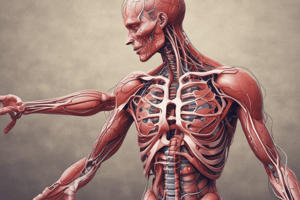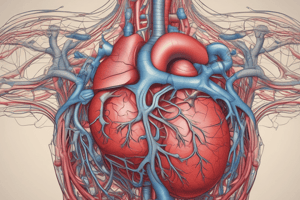Podcast
Questions and Answers
What is the main function of the epicardium?
What is the main function of the epicardium?
- To distribute oxygenated blood to the body
- To regulate the heart rate
- To contract rhythmically to pump blood
- To produce pericardial fluid and protect the inner heart layers (correct)
Which of the following layers of the heart wall is composed of simple squamous epithelium?
Which of the following layers of the heart wall is composed of simple squamous epithelium?
- Myocardium
- Endocardium (correct)
- Epicardium
- Pericardium
What is the primary function of the pericardial cavity?
What is the primary function of the pericardial cavity?
- To regulate blood pressure
- To store blood for the heart
- To facilitate the pumping action of the heart (correct)
- To produce cardiac muscle cells
What is the arrangement of cardiac muscle fibers in the myocardium?
What is the arrangement of cardiac muscle fibers in the myocardium?
What is the middle layer of the heart wall?
What is the middle layer of the heart wall?
What is the function of the loose connective tissue in the myocardium?
What is the function of the loose connective tissue in the myocardium?
What is the subendocardial layer?
What is the subendocardial layer?
What is the composition of the pericardium?
What is the composition of the pericardium?
What is the arrangement of smooth muscle fibers in the walls of vessels larger than capillaries?
What is the arrangement of smooth muscle fibers in the walls of vessels larger than capillaries?
What is the primary function of elastic fibers in vascular walls?
What is the primary function of elastic fibers in vascular walls?
What is the main component of the tunica externa?
What is the main component of the tunica externa?
What is the function of gap junctions in arterioles and small arteries?
What is the function of gap junctions in arterioles and small arteries?
What is the characteristic of the intima in elastic arteries?
What is the characteristic of the intima in elastic arteries?
What is the term for the largest branches of the aorta and pulmonary artery?
What is the term for the largest branches of the aorta and pulmonary artery?
What is the middle layer of the vascular wall composed of?
What is the middle layer of the vascular wall composed of?
What is the function of the tunica media in the vascular wall?
What is the function of the tunica media in the vascular wall?
What is the main function of the sinoatrial (SA) node in the heart?
What is the main function of the sinoatrial (SA) node in the heart?
What type of muscle cells are present in the walls of all blood vessels except capillaries?
What type of muscle cells are present in the walls of all blood vessels except capillaries?
What is the function of the endothelium in the vascular wall?
What is the function of the endothelium in the vascular wall?
What is the characteristic of Purkinje fibers in the heart?
What is the characteristic of Purkinje fibers in the heart?
What is the function of the atrioventricular (AV) node in the heart?
What is the function of the atrioventricular (AV) node in the heart?
What is the function of the endothelium in regulating local vascular tone and blood flow?
What is the function of the endothelium in regulating local vascular tone and blood flow?
What is the role of the endothelium in inflammation and local immune responses?
What is the role of the endothelium in inflammation and local immune responses?
What is the name of the growth factor secreted by endothelial cells under various conditions?
What is the name of the growth factor secreted by endothelial cells under various conditions?
What is the characteristic of the internal elastic lamina in muscular arteries?
What is the characteristic of the internal elastic lamina in muscular arteries?
What is the main function of the elastic laminae in arteries?
What is the main function of the elastic laminae in arteries?
What is the composition of the media in muscular arteries?
What is the composition of the media in muscular arteries?
What is the characteristic of the adventitia in arterioles?
What is the characteristic of the adventitia in arterioles?
What is the main function of capillaries?
What is the main function of capillaries?
What is the characteristic of the continuous, or somatic, capillaries?
What is the characteristic of the continuous, or somatic, capillaries?
What is the characteristic of the media in arterioles?
What is the characteristic of the media in arterioles?
What is the composition of the capillary wall?
What is the composition of the capillary wall?
What is the characteristic feature of the fenestrated capillaries?
What is the characteristic feature of the fenestrated capillaries?
In which organs are sinusoidal capillaries mainly found?
In which organs are sinusoidal capillaries mainly found?
What is the characteristic feature of the postcapillary venules?
What is the characteristic feature of the postcapillary venules?
What is the characteristic feature of the muscular venules?
What is the characteristic feature of the muscular venules?
What is the primary function of veins?
What is the primary function of veins?
What is the characteristic feature of the intima of veins?
What is the characteristic feature of the intima of veins?
What is the composition of the media of veins?
What is the composition of the media of veins?
How does blood move through veins towards the heart?
How does blood move through veins towards the heart?
Flashcards
Circulatory System Parts
Circulatory System Parts
The circulatory system is made of two main parts: the cardiovascular system and the lymphatic system.
Heart Chambers
Heart Chambers
The heart has four chambers: two atria and two ventricles.
Heart Wall Layers
Heart Wall Layers
The heart wall has three layers: the endocardium (inner), myocardium (middle), and epicardium (outer).
Endocardium Layer
Endocardium Layer
Signup and view all the flashcards
Myocardium Layer
Myocardium Layer
Signup and view all the flashcards
Epicardium Layer
Epicardium Layer
Signup and view all the flashcards
Impulse Conducting System
Impulse Conducting System
Signup and view all the flashcards
SA Node
SA Node
Signup and view all the flashcards
Purkinje Fibers
Purkinje Fibers
Signup and view all the flashcards
Blood Vessel Walls
Blood Vessel Walls
Signup and view all the flashcards
Tunica Intima
Tunica Intima
Signup and view all the flashcards
Tunica Media
Tunica Media
Signup and view all the flashcards
Tunica Externa
Tunica Externa
Signup and view all the flashcards
Elastic Arteries
Elastic Arteries
Signup and view all the flashcards
Muscular Arteries
Muscular Arteries
Signup and view all the flashcards
Arterioles
Arterioles
Signup and view all the flashcards
Capillaries
Capillaries
Signup and view all the flashcards
Postcapillary Venules
Postcapillary Venules
Signup and view all the flashcards
Venules
Venules
Signup and view all the flashcards
Veins
Veins
Signup and view all the flashcards
Endothelial Cells
Endothelial Cells
Signup and view all the flashcards
Study Notes
The Circulatory System
- The circulatory system consists of two parts: the cardiovascular system and the lymphatic vascular system.
Heart
- The heart is composed of four chambers: the atria and ventricles, with three major layers: the endocardium, myocardium, and epicardium.
- The endocardium is the inner layer, consisting of endothelium, a middle layer of connective tissue and smooth muscle, and a subendocardial layer of loose connective tissue.
- The myocardium is the middle layer, containing cardiac muscle with fibers arranged spirally around each heart chamber.
- The epicardium is the outer layer, consisting of a simple squamous mesothelium supported by a layer of loose connective tissue containing blood vessels and nerves.
Impulse Conducting System
- The impulse conducting system consists of the sinoatrial (SA) node, the atrioventricular (AV) node, the AV bundle (of His), and Purkinje fibers.
- The Purkinje fibers are pale-staining, larger than adjacent contractile muscle fibers, with sparse, peripheral myofibrils and much glycogen.
Tissues of the Vascular Wall
- The walls of all blood vessels except capillaries contain smooth muscle and connective tissue in addition to the endothelial lining.
- The endothelium acts as a semipermeable barrier between blood plasma and interstitial tissue fluid.
- Endothelial cells have several functions, including:
- Presenting a nonthrombogenic surface
- Regulating local vascular tone and blood flow
- Participating in inflammation and local immune responses
- Secreting growth factors
Blood Vessel Walls
- All blood vessels except capillaries have walls with three concentric layers or tunics: the tunica intima, tunica media, and tunica externa.
- The tunica intima consists of the endothelium and a thin subendothelial layer of loose connective tissue.
- The tunica media consists of concentric layers of helically arranged smooth muscle cells, elastic fibers, and reticular fibers.
- The tunica externa consists of type I collagen and elastic fibers.
Elastic Arteries
- Elastic arteries are conducting arteries, including the aorta, pulmonary artery, and their largest branches.
- The intima is well-developed, with many smooth muscle cells in the subendothelial connective tissue.
- The media is thick, with elastic laminae alternating with layers of smooth muscle fibers.
Muscular Arteries
- Muscular arteries distribute blood to organs and help regulate blood pressure by contracting or relaxing smooth muscle in the media.
- The intima has a very thin subendothelial layer and a prominent internal elastic lamina.
- The media may contain up to 40 layers of large smooth muscle cells interspersed with elastic laminae.
Arterioles
- Arterioles are the smallest arteries, branching from muscular arteries.
- The subendothelial layer is very thin, and elastic laminae are absent.
- The media consists of circularly arranged smooth muscle cells.
Capillaries
- Capillaries are composed of a single layer of endothelial cells rolled up as a tube.
- They permit and regulate metabolic exchange between blood and surrounding tissues.
- There are three histologic types of capillaries: continuous, fenestrated, and discontinuous (sinusoidal) capillaries.
Postcapillary Venules and Venules
- Postcapillary venules converge into larger collecting venules.
- The tunica intima of these vessels is composed of endothelium and a very thin subendothelial layer.
- Venules become surrounded by a recognizable tunica media with two or three smooth muscle layers.
Veins
- Veins carry blood back to the heart from microvasculature all over the body.
- Blood entering veins is under very low pressure and moves toward the heart by contraction of smooth muscle fibers in the media and by external compressions from surrounding muscles and other organs.
Studying That Suits You
Use AI to generate personalized quizzes and flashcards to suit your learning preferences.




